The Sorting Hampers Market is estimated to be valued at USD 4162.4 million in 2025 and is projected to reach USD 7596.0 million by 2035, registering a compound annual growth rate (CAGR) of 6.2% over the forecast period.
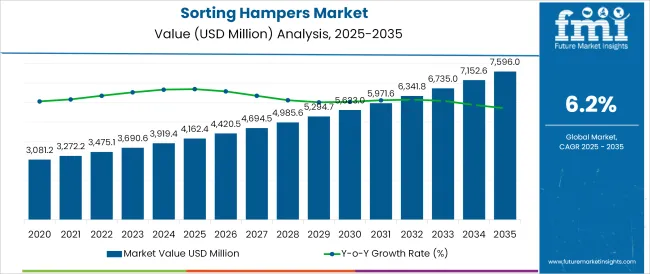
The sorting hampers market is experiencing steady growth due to rising demand for organized storage solutions across residential and industrial environments. Increasing urbanization, limited living space, and heightened focus on cleanliness and organization have propelled the adoption of multi-compartment, ergonomically designed hampers in households.
In commercial settings, particularly in food, healthcare, and hospitality industries, sorting hampers are increasingly being integrated into automated workflow systems to improve hygiene, reduce cross-contamination, and support lean inventory practices. Advances in durable, antimicrobial materials and ergonomic features such as collapsible frames and casters have broadened the functional and aesthetic appeal of hampers.
Moreover, the shift toward eco-friendly materials and sustainable design has opened opportunities for innovation and branding, especially in retail and institutional procurement. As hygiene protocols and sorting needs become more specialized across sectors, the market is expected to expand through modular and sector-specific product offerings with enhanced durability and design flexibility.
The market is segmented by Application and End-Use Industry and region. By Application, the market is divided into Residential and Commercial. In terms of End-Use Industry, the market is classified into Food, Pharmaceutical, Construction, Courier & Logistics, Sporting Goods, and Automotive.
Regionally, the market is classified into North America, Latin America, Western Europe, Eastern Europe, Balkan & Baltic Countries, Russia & Belarus, Central Asia, East Asia, South Asia & Pacific, and the Middle East & Africa.
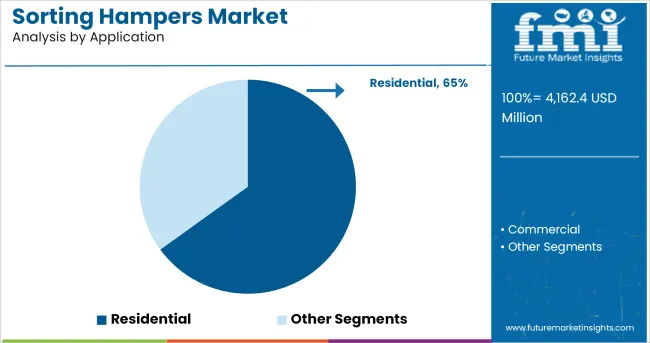
The residential segment is projected to contribute 65.0% of the total revenue share in 2025 under the application category, solidifying its position as the leading use case. This dominance has been driven by changing consumer behaviour emphasizing hygiene, home organization, and multi-use utility solutions
Increased urban living and reduced household space have led to a surge in demand for compact, multi-compartment sorting hampers that aid in laundry separation, waste sorting, and general storage. Product aesthetics have also played a key role, with consumers favoring designs that blend functionality with interior décor.
Manufacturers have responded with a variety of sizes, colours, and materials ranging from breathable fabrics to sustainable bamboo structures offering affordable options that appeal to a wide consumer base. Online retail growth and increased home improvement activities have further supported demand, reinforcing the residential segment’s leadership.

The food industry is anticipated to hold a 28.0% revenue share in 2025 within the end-use category, positioning it as the leading industrial segment. This leadership is underpinned by stringent hygiene standards and operational efficiency requirements within food manufacturing, processing, and distribution environments
Sorting hampers play a critical role in handling food-grade materials, waste segregation, and organizing cleanroom or cold chain logistics. The preference for antimicrobial, easy-to-clean, and stackable designs has supported adoption in production facilities and institutional kitchens. Customization to accommodate color-coded sorting systems, weight tolerance, and contamination risk reduction has further strengthened the segment’s relevance.
Moreover, the rise in commercial kitchens, cloud-based food services, and packaged food logistics has intensified the need for robust sorting systems, ensuring that the food industry remains a primary end-use vertical in the sorting hampers market.
According to the latest research by Future Market Insights, the sorting hampers market is set to witness steady growth during 2025 to 2035, with a CAGR of around 6%.
Demand for sorting hamper will witness steady growth owing to the factors such as fueling of demand for automation in the food industry, improving the economic conditions, urbanization, and growing need to improve the working efficiency in the packaging unit. Such factors are likely to boost the demand for sorting hampers in the market.
The rising demand from various industries and residential areas is expected to fuel the demand for the sorting hampers industry.
Additionally, industries involving mass production and exporting of goods like from Pharmaceutical and Automotive industries serve as a high significance for the sorting hampers industry as arranging products will help in improving the work efficiency and will guarantee limited process time.
Further, residential areas also have a huge demand for sorting hampers as consumers like to keep their books, medicines, clothes, etc., in an arranged manner to save them time instead of exploring the whole lot. The busy lifestyles of individuals and changing preferences create an opportunity for the sorting hamper to grow in the residential area.
The growing implementation of optical sorting in the food industry, an alternative to manual sorting attributing to the rise in shortage of labor, and an enlarged interest from consumers to be served with top-notch systems are likely to grow the sales of sorting hampers.
Further, the rising labor cost is likely to demand the service providers to implement self-service, thus, growing the demands and sales of sorting hamper.
With rapid urbanization and the rising need to integrate the industries in order to boost production, sorting hamper are likely to help the employees to reduce human effort and improve efficiency.
This will result in helping the industry to spread their business worldwide and stand out in the growing competitiveness. This would help them to make more than their estimated projections, thus, creating new opportunities for the sorting hampers industry.
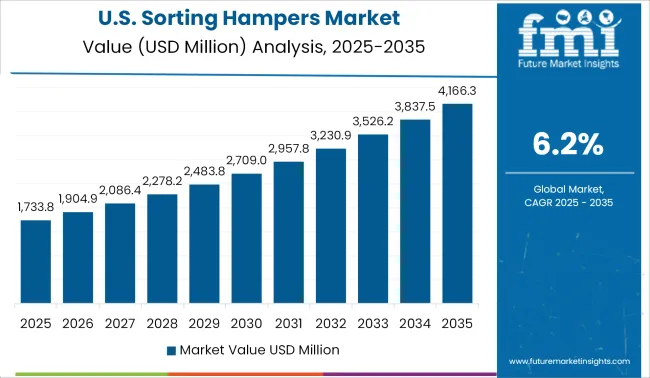
The countries of North America are the largest market for the implementation of sorting hamper globally. The rising population leading to the creation of waste from residential and commercial sectors is likely to grow tremendously thus, boosting the demand and sales of sorting hamper.
Further, the industries are currently, heavily reliant on the laborers to conduct their automation process which increases the chance of risk in business, therefore, growing the demand for improvement in the automation of systems to improve efficiency.
Such regions are also experiencing growing demand from consumers due to development in technologies and adoption of digital platforms, which is encouraging the presence of individuals more on the internet and e-commerce. In order to maintain a large and transparent inventory and allow the business to run smoothly, the demand for sorting hampers is likely to grow in the forecast period.
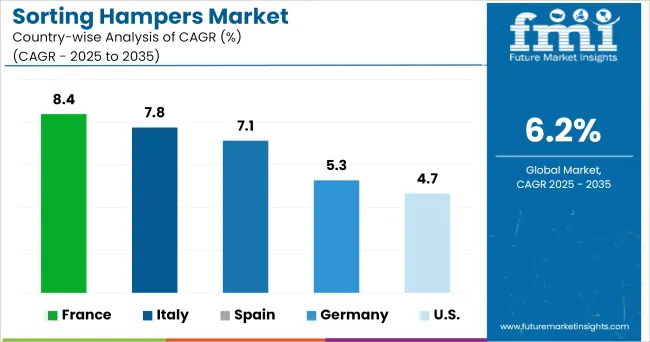
However, with the changing methodologies among manufacturers and suppliers and rising demand for the latest automation of work processes in order to save time and money and focus on customer experience, the adoption of sorting hamper is likely to grow.
Due to the presence of various large industrialists and a huge global spread in terms of land, the regions account for almost one-third of the market share overall.
Thus, the return is as good as five times the investment, encouraging the growth of automated sorting techniques in order to reduce human effort. Further, the growing expansion with other developing countries is likely to recreate the demand for sorting hamper.
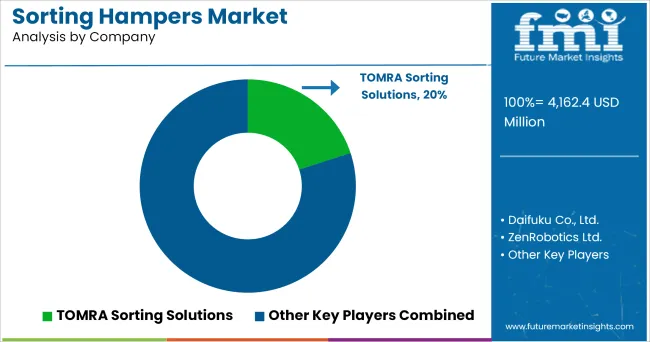
Some of the leading manufacturers and suppliers of sorting hampers include
The report is a compilation of first-hand information, qualitative and quantitative assessment by industry analysts, inputs from industry experts and industry participants across the value chain.
The report provides in-depth analysis of parent market trends, macro-economic indicators and governing factors along with market attractiveness as per segments. The report also maps the qualitative impact of various market factors on market segments and geographies.
The global sorting hampers market is estimated to be valued at USD 4,162.4 million in 2025.
The market size for the sorting hampers market is projected to reach USD 7,596.0 million by 2035.
The sorting hampers market is expected to grow at a 6.2% CAGR between 2025 and 2035.
The key product types in sorting hampers market are residential and commercial.
In terms of end-use industry, food segment to command 28.0% share in the sorting hampers market in 2025.






Full Research Suite comprises of:
Market outlook & trends analysis
Interviews & case studies
Strategic recommendations
Vendor profiles & capabilities analysis
5-year forecasts
8 regions and 60+ country-level data splits
Market segment data splits
12 months of continuous data updates
DELIVERED AS:
PDF EXCEL ONLINE
Sorting Equipment Market Size and Share Forecast Outlook 2025 to 2035
Sorting and Grading Machines Market Size and Share Forecast Outlook 2025 to 2035
Food Sorting Machine Market Size and Share Forecast Outlook 2025 to 2035
Cell Sorting Market Share Analysis: Global Industry Analysis and Opportunity Assessment 2025 to 2035
Cash Sorting Machines Market
AI Waste Sorting Robots Market Forecast and Outlook 2025 to 2035
Vegetable Sorting Machine Market Analysis by Processing Capacity, Technology, Operation Type, Vegetable Type, and Region Through 2035
Fluorescence-Activated Cell Sorting Market Size and Share Forecast Outlook 2025 to 2035

Thank you!
You will receive an email from our Business Development Manager. Please be sure to check your SPAM/JUNK folder too.
Chat With
MaRIA